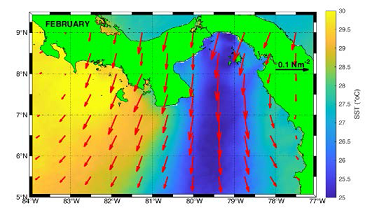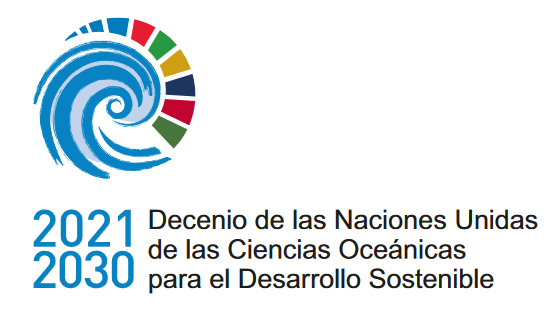Caracterización de las condiciones oceanográficas cerca de la Isla Coiba y el Pacífico de Panamá utilizando 20 años de mediciones satelitales de estrés del viento, TSM y clorofila-a
DOI:
https://doi.org/10.47193/mafis.37X2024010112Palabras clave:
Hidrografía, estrés eólico, temperatura superficial, clorofilas, surgenciasResumen
La Isla Coiba y la Zona Especial de Protección Marina asociada representan una reserva marina importante, aunque poco estudiada, a lo largo de la costa del Pacífico de Panamá. Si bien recientemente se han iniciado esfuerzos para establecer programas de monitoreo en la región, ya existe una variedad de mediciones ambientales históricas relacionadas con el mar, derivadas de observaciones satelitales. El objetivo de este artículo fue utilizar conjuntos de datos a largo plazo para variables clave para proporcionar información cualitativa (es decir, oceanografía descriptiva) de las condiciones climatológicas y variabilidad interanual en la región del Pacífico de Panamá. Estos se basan en evaluaciones numéricas, lo que proporciona una base importante para estudios en curso y futuros, particularmente en la región de la Isla Coiba y el Golfo de Chiriquí. En particular, examinamos 20 años (enero de 2003-diciembre de 2022) de estrés eólico, temperatura de la superficie del mar (TSM) y clorofila-a (Chl-a), que abarcan las regiones neríticas y pelágicas de la costa del Pacífico de Panamá. Durante la estación seca (invierno del norte), el conocido chorro de viento estacional regional de Panamá apareció a lo largo del Golfo de Panamá, lo que provocó una mezcla de la superficie y un enfriamiento de la TSM que finalmente se extendió por la mayor parte de la Bahía de Panamá. Al oeste de la Península de Azuero, la TSM aumentó y el calentamiento de la superficie se extendió más lejos de la costa desde enero hasta abril. La TSM en el Golfo de Chiriquí durante este período fue alrededor de 1° C más cálida en promedio que al este de la Isla Coiba. En julio y agosto, los gradientes de TSM en alta mar se volvieron en gran medida longitudinales, se produjo un enfriamiento a lo largo de la temporada, y la TSM a ambos lados de la isla Coiba fue casi la misma. La influencia del chorro de Panamá en el Golfo de Panamá también fue evidente en los datos de Chl-a, con valores impulsados por las surgencias que alcanzaron su punto máximo en febrero/marzo (hasta 11 mg m-3, con un valor climatológico mensual de alrededor de 2 mg m-3 durante este período). Durante el resto del año, la concentración de Chl-a en esta región promedió alrededor de 0,5-1,0 mg m-3. En el Golfo de Chiriquí y la región al este de la Isla Coiba, los promedios climatológicos mensuales fueron aproximadamente 0,3-0,5 mg m-3 y 0,4 - 0,6 mg m-3, respectivamente. Algo sorprendente es que en los datos satelitales del Golfo de Chiriquí durante mayo de 2007 y junio de 2008 estuvieron presentes valores muy altos de Chl-a, alcanzando un máximo de 16 mg m-3 y 32 mg m-3 en un lugar justo al oeste de la isla Coiba, respectivamente. Aún no está clara la causa de estas aparentes floraciones. Sin embargo, incluso cuando se excluyeron los valores altos de Chl-a en el cálculo de los promedios climatológicos en el Golfo de Chiriquí, hay una sugerencia de estacionalidad modesta en los valores de Chl-a, con valores ligeramente elevados (~ 0,4 mg m-3) que alcanzan su punto máximo alrededor de mayo y octubre. Durante el evento extremo de El Niño de 2015-2016, el promedio mensual de TSM a lo largo de la costa del Pacífico de Panamá fue más cálida que el promedio, con niveles elevados de hasta + 2 °C y con duración de 12 meses en el Golfo de Chiriquí. En el Golfo de Panamá, las anomalías promedio mensuales de la TSM fueron de hasta + 1,7 °C, aunque las temperaturas volvieron a los promedios casi estacionales después de aproximadamente 5 meses.
Descargas
Métricas
Citas
Acker JG, Leptoukh G. 2007. Online analysis enhances use of NASA earth science data. Eos Trans. 88 (2): 14-17. DOI: https://doi.org/10.1029/2007EO020003
Alvarado J, Guzmán H, Breedy O. 2012. Distribution and diversity of echinoderms in the islands of the Gulf of Chiriqui, Panama. Rev Bio Mar Oceanogr. 47 (1):13-22.
Amador JA, Alfaro EJ, Lizano OG, Magana VO. 2006. Atmospheric forcing of the eastern tropical Pacific: a review. Prog Oceanogr. 60: 101-142.
Amador, JA, Duran-Quesada, AM, Mora, G, Saenz, F, Calderon, B, Mora, N. 2016a. The easternmost tropical Pacific. Part II: seasonal and intraseasonal modes of atmospheric variability. Rev Biol Trop. 64 (1): 23-57. DOI: https://doi.org/10.15517/rbt.v64i1.23409
Amador, JA, Rivera, ER, Duran-Quesada, AM, Mora, G, Saenz, F, Calderon, B, Mora, N. 2016b. The easternmost tropical Pacific. Part I: a climate review. Rev Biol Trop. 64 (1): 1-22. DOI: https://doi.org/10.15517/rbt.v64i1.23407
Ballance LT, Pitman RL, Fiedler PC. 2006. Oceanographic influences on seabirds and cetaceans of the eastern tropical Pacific: a review. Prog Oceanogr. 69: 360-390.
Brugnoli Olivera E, Molina L, Till, I, Camarena M, Morales-Ramírez A, Díaz-Ferguson E. 2023. Mesozooplankton and oceanographic conditions in the North zone of Coiba National Park (Panamá, Central America). Reg Stud Mar Sci. 66: 103136. DOI: https://doi.org/10.1016/j.rsma.2023.103136
Camilli R, Pizarro O, Camilli L. 2007. Rapid swath mapping of reef ecology and associated water column chemistry in the Gulf of Chiriqui, Panama. Proceedings of MTS/IEEE Oceans 2007. Vancouver: Institute of Electrical and Electronics Engineers. p. 1-8. DOI: https://doi.org/10.1109/OCEANS.2007.4449413
Camilli L, Pizarro O, Camilli R. 2008. Advancing spatial-temporal continuity in coral reef ecosystem pattern detection: the morphology, distribution and chemical environments of coral habitats encompassing Coiba National Park, Panamá. Proceedings of the 11th International Coral Reef Symposium; 2008 July 7-11. Ft. Lauderdale, FL, Davie, FL: Nova Southeastern University National Coral Reef Institute. p. 515-519.
Cardona V, Brugnoli E, Díaz-Ferguson E, Morales A. 2021. Biología y métodos del estudio del zooplankton gelatinoso con énfasis en investigaciones del Pacifico Este Tropical. Tecnociencia. 23 (2): 273-300.
Chaigneau A, Abarca del Rio R, Colas Francois. 2006. Lagrangian study of the Panama Bight and surrounding regions. J Geophys Res. 111: C09013. DOI: https://doi.org/10.1029/2006JC003530
Colley SB, Glynn PW, May AS, Mate JL. 2006. Species-dependent reproductive responses of eastern Pacific corals to the 1997-1998 ENSO event. Proceedings of the 10th International Coral Reef Symposium. p. 61-70.
Corredor-Acosta A, Chong NC, Acosta A, Pizarro-Koch M, Vargas A, Medellin-Mora J, Saldias GS, Echeverry-Guerra V, Gutierrez-Fuentes J, Betancur-Turizo S. 2020. Spatio-temporal variability of chlorophyll-a and environmental variables in the Panama Bight. Remote Sens. 12: 2150. DOI: https://doi.org/10.3390/rs12132150
Corredor-Acosta A, Gaspar P, Calmettes B. 2001. Variation in the surface current in the Panama Bight during El Niño and La Niña events from 1993 to 2007. Bol Invest Mar Cost. 40: 33-56.
D’Croz L, Mate JL, Oke JE. 2001. Responses to elevated sea water temperature and UV radiation in the coral P. lobate from upwelling and non-upwelling environments on the Pacific coast of Panama. Bull Mar Sci. 69 (1): 203-214.
D’Croz L, O’Dea A. 2007. Variability in upwelling along the Pacific shelf of Panama and implications for the distribution of nutrients and chlorophyll. Estuar Coast Shelf Sci. 73: 325-340.
D’Croz L, Robertson DR. 1997. Coastal oceanographic conditions affecting coral reefs on both sides of the Isthmus of Panama. Proceedings of the 18th International Coral Reef Symposium. 2 (205): 2053-2058.
Devis-Morales A, Schneider W, Montoya-Sanchez RA, Rodriguez-Rubio E. 2008. Monsoon-like winds reverse oceanic circulation in the Panama Bight. Geophys Res Lett. 35: L20607. DOI: https://doi.org/10.1029/2008GL035172
Enright SG, Meneses-Orellana R, Keith I. 2021. The Eastern Tropical Pacific Marine Corridor (CMAR): the emergence of a voluntary regional cooperation mechanism for the conservation and sustainable use of marine biodiversity within a fragmented regional ocean governance landscape. Front Mar Sci. 8:674825. DOI: https://doi.org/10.3389/fmars.2021.674825
Fernandez-Álamo MA, Farber-Lorda J. 2006. Zooplankton and the oceanography of the eastern tropical Pacific: a review. Prog Oceanogr. 69: 318-359.
Fiedler PC, Talley LD. 2006. Hydrography of the eastern tropical Pacific: a review. Prog Oceanogr. 69: 143-180.
Garcia-Franco, JL, Chadwick, R, Gray, LJ, Osprey, S, Adams, DK. 2023. Revisiting mechanisms of the Mesoamerican Midsummer drought. Climate Dyn. 60: 549-569. DOI: https://doi.org/10.1007/s00382-022-06338-6
[GMAO] Global Modeling and Assimilation Office. 2015. MERRA-2 tavgM_2d_flx_Nx: 2d, monthly mean, time-averaged, single-level, assimilation, surface flux diagnostics V5.12.4. Greenbelt: Goddard Earth Sciences Data and Information Services Center. [accessed 2023 May 25]. DOI: https://doi.org/10.5067/0JRLVL8YV2Y4
Guzmán HM, Beaver CE, Díaz-Ferguson E. 2021. Novel insights into the genetic population connectivity of transient whale sharks (Rhincodon typus) in Pacific Panama provide crucial data for conservation efforts. Front Mar Sci. 8: 744109. DOI: https://doi.org/10.3389/fmars.2021.744109
Harvey ET, Kratzer S, Philipson P. 2015. Satellite-based water quality monitoring for improved spatial and temporal retrieval of chlorophyll-a in coastal waters. Rem Sense Env. 158: 417-430. DOI: https://doi.org/10.1016/j.rse.2014.11.017
Herrera Carmona JC, Selvaraj JJ, Giraldo A. 2022. Dynamic regionalization of the Panama Bight, Eastern Tropical Pacific, using remote sensing data. Int J Remote Sens. 43 (9): 313103151. DOI: https://doi.org/10.1080/01431161.2022.2063040
Hu C, Feng L, Lee Z, Franz BA, Bailey SW, Werdell PJ, Proctor CW. 2019. Improving satellite global chlorophyll a data products through algorithm refinement and data recovery. J Geophys Res. 124: 1524-1543. DOI: https://doi.org/10.1029/2019JC014941
Hu S, Fedorov AV. 2019. The extreme El Niño of 2015-2016: the role of westerly and easterly wind bursts, and preconditioning by the failed 2014 event. Climate Dyn. 52: 7339-7357. DOI: https://doi.org/10.1007/s00382-017-3531-2
Huffman GJ, Stocker EF, Bolvin DT, Nelkin EJ, Jackson T. 2023. GPM IMERG Final Precipitation L3 1 day 0.1 degree x 0.1 degree V07, Greenbelt, MD, Goddard Earth Sciences Data and Information Services Center (GES DISC). [accessed 2023 Sep 14]. DOI: https://doi.org/10.5067/GPM/IMERGDF/DAY/07
Jiang W, Knight BR, Cornelisen C, Barter P, Kudela R. 2017. Simplifying regional tuning of MODIS algorithms for monitoring chlorophyll-a in coastal waters. Front Mar Sci. 4: 151. DOI: https://doi.org/10.3389/fmars.2017.00151
Kessler WS. 2006. The circulation of the eastern tropical Pacific: a review. Prog Oceanogr. 69: 181-217.
Lavigne H, Van der Zande D, Ruddick K, Cardoso Dos Santos JF, Gohin F, Brotas V, Kratzer S. 2021. Quality-control tests for OC4, OC5 and NIR-red satellite chlorophyll-a algorithms applied to coastal waters. Rem Sens Env. 255: 112237. DOI: https://doi.org/10.1016/j.rse.2020.112237
Maté J, Tovar D, Arcia E, Hidalgo Y. 2009. Plan de manejo del Parque Nacional Coiba. Autoridad Nacional del Ambiente. 160 p.
Mestas-Nunez AM, Miller AJ. 2006. Interdecadal variability and climate change in the eastern tropical Pacific: a review. Prog Oceanogr. 69: 267-284.
[NASA OBPG] The National Aeronautics and Space Administration Ocean Biology Processing Group. 2019a. MODIS Aqua Level 3 SST Thermal IR Daily 4km Daytime V2019.0. California: Physical Oceanography Distributed Active Archive Center (PO.DAAC). [accessed 2023 May 25]. DOI: https://doi.org/10.5067/MODSA-1D4D9
[NASA OBPG] The National Aeronautics and Space Administration Ocean Biology Processing Group. 2019b. MODIS Aqua Level 3 SST MID-IR Monthly 4km Nighttime V2019.0. California: Physical Oceanography Distributed Active Archive Center (PO.DAAC). [accessed 2023 May 25]. DOI: https://doi.org/10.5067/MODAM-MO4N9
[NASA OBPG] The National Aeronautics and Space Administration Ocean Biology Processing Group. 2022. Moderate-resolution Imaging Spectroradiometer (MODIS) Aqua Chlorophyll Data; 2022 reprocessing. Greenbelt: NASA Ocean Biology Distributed Active Archive Center (OB.DAAC). [accessed 2023 May 25]. DOI: https://doi.org/10.5067/AQUA/MODIS/L3M/CHL/2022
O’Reilly JE, Werdell PJ. 2019. Chlorophyll algorithms for ocean color sensors - OC4, OC5 & OC6. Rem Sens Env. 229: 32-47.
Pawlowicz R. 2021. M_Map: a mapping package for MATLAB, version 1.4n. https://www.eoas.ubc.ca/~rich/map.html.
Pennington JT, Mahoney KL, Kuwahara VS, Kolber DD, Calienes R, Chavez FP. 2006. Primary production in the eastern tropical Pacific: a review. Prog Oceanogr. 69: 285-317.
Podesta GP, Glynn PW. 1997. Sea surface temperature variability in Panama and Galapagos: extreme temperatures causing coral bleaching. J Geophys Res. 102 (C7): 15749-15759.
Rodriguez-Rubio E, Stuardo J. 2002. Variability of photosynthetic pigments in the Columbian Pacific Ocean and its relationship with the wind field using ADEOS-I data. Proc Indian Acad Sci (Earth Planet Sci). 111 (3): 227-236.
Rodriguez-Rubio E, Schneider W, Aberca del Rio R. 2003. On the seasonal circulation within the Panama Bight derived from satellite observations of wind, altimetry and sea surface temperature. Geophys Res Lett. 30 (7): 1410. DOI: https://doi.org/10.1029/2002GL016794
Santoso, A, Mcphaden MJ, Cai W. 2017. The defining characteristics of ENSO extremes and the strong 2015/2016 El Niño. Rev Geophys. 55: 1079-1129. DOI: https://doi.org/10.1002/2017RG000560
Smayda TJ. 1966. A quantitative analysis of the phytoplankton of the Gulf of Panama. III. General ecological conditions and the phytoplankton dynamics at 8° 45’ N, 79° 23’ W from November 1954 to May 1957. Inter-American Tropical Tuna Commission Bulletin. 11: 353-612.
Tilstone GH, Lotliker AA, Miller PI, Ashraf PM, Kumar TS, Suresh T, Ragavan BR, Menon HB. 2013. Assessment of MODIS-Aqua chlorophyll-a algorithms in coastal and shelf waters of the eastern Arabian Sea. Cont Shelf Res. 65: 14-265. DOI: https://doi.org/10.1016/j.csr.2013.06.003
The MathWorks Inc. 2022. MATLAB version: 9.13.0 (R2022b), Natick, Massachusetts: The MathWorks Inc. https://www.mathworks.com.
Wang C, Fiedler PC. 2006. Eddies and tropical instability waves in the eastern tropical Pacific: a review. Prog Oceanogr. 69: 218-238.
Willett CS, Leben RR, Lavin MF. 2006. ENSO variability and the eastern tropical Pacific: a review. Prog Oceanogr. 69: 239-266.
Wyrtki K. 1966. Oceanography of the eastern equatorial Pacific Ocean. Oceanogr Mar Biol Ann Rev. 4: 33-68.

Descargas
Publicado
Cómo citar
Número
Sección
Licencia
Derechos de autor 1970 Greg Crawford, Matthew Mepstead, Edgardo Díaz-Ferguson

Esta obra está bajo una licencia internacional Creative Commons Atribución-NoComercial-CompartirIgual 4.0.
Los autores de los artículos publicados en Marine and Fishery Sciences conservan los derechos de autor de sus artículos, a excepción de las imágenes de terceros y otros materiales añadidos por Marine and Fishery Sciences, que están sujetos a los derechos de autor de sus respectivos propietarios. Por lo tanto, los autores son libres de difundir y volver a publicar sus artículos, sujeto a los requisitos de los propietarios de derechos de autor de terceros y sujeto a que la publicación original sea completamente citada. Los visitantes también pueden descargar y reenviar artículos sujetos a los requisitos de citas. La capacidad de copiar, descargar, reenviar o distribuir cualquier material siempre está sujeta a los avisos de derechos de autor que se muestran. Los avisos de copyright deben mostrarse de manera prominente y no pueden borrarse, eliminarse u ocultarse, total o parcialmente. El autoalmacenamiento en servidores y repositorios de preimpresión está permitido para todas las versiones.
Esta revista ofrece a los autores una política de acceso abierto. Los usuarios pueden leer, descargar, copiar, distribuir, imprimir, buscar o vincular los textos completos de los artículos, o usarlos para cualquier otro propósito legal dentro de la licencia Creative Commons 4.0 (BY-NC-SA), sin solicitar permiso previo del editor o del autor. Esto está de acuerdo con la definición BOAI de acceso abierto.



























